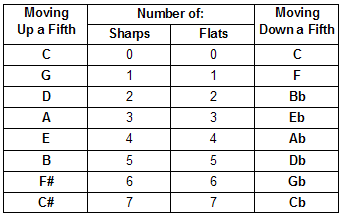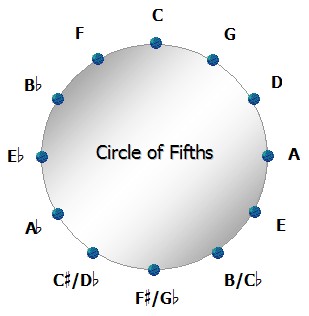This required note alteration is indicated by using sharps or flats placed appropriately on the staff, immediately following the clef. Key signatures contain a specific pattern of either sharps or flats but never both.
The key signature in the example below shows that for the B![]() scale we previously derived, all instances of the notes B and E must automatically be read as flatted.
scale we previously derived, all instances of the notes B and E must automatically be read as flatted.

Only the key of C contains no sharps or flats. The other key signatures can be methodically derived by moving either up or down from C in intervals of a perfect fifth.
As the table below illustrates, moving up 7 consecutive fifths yields the family of keys defined by sharped notes, while moving down in the same fashion generates the family of keys defined by flatted notes.

The progression of key signatures is often depicted as a circle of fifths.

Applying the rule for the Major scale to each starting note on the circle, we find that the scales associated with keys that are adjacent to each other differ in the value of only one note. Neighboring keys are therefore considered to be more closely related than keys that are farther away.
From a compositional standpoint, it is easiest to move, or modulate, between related keys.
When it is necessary to temporarily undo the effect of the key signature on a particular note, the natural sign (![]() ) is used. Once written in front of the note it modifies, it remains in effect for all other instances of the note for the duration of the measure in which it appears.
) is used. Once written in front of the note it modifies, it remains in effect for all other instances of the note for the duration of the measure in which it appears.